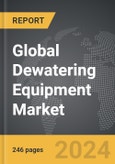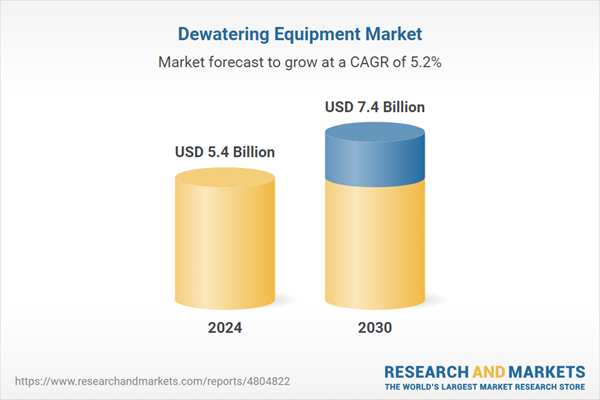Global Dewatering Equipment Market - Key Trends and Drivers Summarized
What Is Dewatering Equipment and How Does It Impact Industrial Efficiency?
Dewatering equipment plays a pivotal role in numerous industries by removing water from solid material or soil. This process is crucial in construction sites, mining operations, wastewater treatments, and agricultural activities, where managing water content is essential for efficiency and environmental compliance. Types of dewatering equipment include centrifuges, belt presses, vacuum filters, and sludge dryers, each tailored to different scales and types of operations. For instance, centrifuges are highly effective for processing large volumes of liquid at high speeds, making them ideal for mining and large-scale wastewater treatment plants. The ability to control moisture levels not only ensures a safer and more efficient site operation but also significantly reduces the cost associated with handling and disposing of waste products. This reduction in operational costs and the subsequent increase in productivity underscores the critical nature of dewatering equipment in industrial operations.How Are Technological Advancements Enhancing Dewatering Processes?
Innovations in dewatering technology have significantly improved the efficiency and environmental compliance of these systems. Modern dewatering equipment features enhanced automation and control systems that optimize water removal, adjust to varying input loads, and minimize energy consumption. These systems use real-time data monitoring to ensure optimal performance and can adjust operations automatically based on the moisture content of the material being processed. Additionally, advancements in materials science have led to the development of more durable and corrosion-resistant components that extend the lifespan of dewatering equipment and reduce maintenance needs. These technological enhancements not only contribute to operational efficiency but also help industries meet stricter environmental regulations by improving waste management and reducing the release of pollutants.What Industries Benefit Most From Advanced Dewatering Solutions?
The construction and mining sectors are among the primary beneficiaries of advanced dewatering solutions. In construction, dewatering equipment is critical for excavating foundations, underground spaces, and trenches in water-logged areas, ensuring structural stability and worker safety. In the mining industry, dewatering is essential to access deeper seams of minerals and to manage water in mineral processing activities. Effective dewatering systems help these industries mitigate environmental impacts, such as reducing the risk of soil erosion and preventing waterlogged waste from contaminating local waterways. Furthermore, the agricultural sector also sees significant benefits from dewatering equipment, especially in managing water bodies and maintaining soil conditions that are conducive to crop growth. By optimizing water levels, farmers can prevent crop damage due to excessive moisture and enhance soil health, leading to better agricultural outputs.What Drives the Growing Market for Dewatering Equipment?
The growth in the dewatering equipment market is driven by several factors, including the global increase in construction and mining activities, heightened environmental regulations, and advancements in dewatering technology. As urbanization and industrial development continue to rise, the demand for effective water management solutions escalates, particularly in regions prone to high water tables or heavy rainfall. The tightening of environmental regulations globally compels industries to invest in superior dewatering techniques that ensure compliance and minimize ecological impacts. Additionally, the push towards sustainability has led industries to adopt energy-efficient and water-conserving practices, which further fuels the demand for advanced dewatering systems. Consumer behavior also contributes to market growth, as stakeholders from various sectors seek innovative solutions to improve operational efficiency and reduce environmental footprints. These diverse drivers ensure a dynamic and expanding market for dewatering equipment, reflecting its integral role in modern industrial activities.Report Scope
The report analyzes the Dewatering Equipment market, presented in terms of market value (USD). The analysis covers the key segments and geographic regions outlined below.- Segments: Technology Type (Centrifuges, Vacuum Filters, Sludge Lagoon, Belt Filter Press, Other Technology Types); Application (Industrial, Municipal).
- Geographic Regions/Countries: World; United States; Canada; Japan; China; Europe (France; Germany; Italy; United Kingdom; Spain; Russia; and Rest of Europe); Asia-Pacific (Australia; India; South Korea; and Rest of Asia-Pacific); Latin America (Argentina; Brazil; Mexico; and Rest of Latin America); Middle East (Iran; Israel; Saudi Arabia; United Arab Emirates; and Rest of Middle East); and Africa.
Key Insights:
- Market Growth: Understand the significant growth trajectory of the Centrifuges segment, which is expected to reach US$1.8 Billion by 2030 with a CAGR of 5.8%. The Vacuum Filters segment is also set to grow at 5.1% CAGR over the analysis period.
- Regional Analysis: Gain insights into the U.S. market, valued at $1.4 Billion in 2024, and China, forecasted to grow at an impressive 8% CAGR to reach $1.7 Billion by 2030. Discover growth trends in other key regions, including Japan, Canada, Germany, and the Asia-Pacific.
Why You Should Buy This Report:
- Detailed Market Analysis: Access a thorough analysis of the Global Dewatering Equipment Market, covering all major geographic regions and market segments.
- Competitive Insights: Get an overview of the competitive landscape, including the market presence of major players across different geographies.
- Future Trends and Drivers: Understand the key trends and drivers shaping the future of the Global Dewatering Equipment Market.
- Actionable Insights: Benefit from actionable insights that can help you identify new revenue opportunities and make strategic business decisions.
Key Questions Answered:
- How is the Global Dewatering Equipment Market expected to evolve by 2030?
- What are the main drivers and restraints affecting the market?
- Which market segments will grow the most over the forecast period?
- How will market shares for different regions and segments change by 2030?
- Who are the leading players in the market, and what are their prospects?
Report Features:
- Comprehensive Market Data: Independent analysis of annual sales and market forecasts in US$ Million from 2024 to 2030.
- In-Depth Regional Analysis: Detailed insights into key markets, including the U.S., China, Japan, Canada, Europe, Asia-Pacific, Latin America, Middle East, and Africa.
- Company Profiles: Coverage of players such as Alfa Laval AB, ANDRITZ AG, Aqseptence Group, Dewaco, Flo Trend and more.
- Complimentary Updates: Receive free report updates for one year to keep you informed of the latest market developments.
Some of the 46 companies featured in this Dewatering Equipment market report include:
- Alfa Laval AB
- ANDRITZ AG
- Aqseptence Group
- Dewaco
- Flo Trend
- GEA Group AG
- Hiller GmbH
- HUBER SE
- PHOENIX Process Equipment Co.
- Veolia Water Technologies
This edition integrates the latest global trade and economic shifts into comprehensive market analysis. Key updates include:
- Tariff and Trade Impact: Insights into global tariff negotiations across 180+ countries, with analysis of supply chain turbulence, sourcing disruptions, and geographic realignment. Special focus on 2025 as a pivotal year for trade tensions, including updated perspectives on the Trump-era tariffs.
- Adjusted Forecasts and Analytics: Revised global and regional market forecasts through 2030, incorporating tariff effects, economic uncertainty, and structural changes in globalization. Includes historical analysis from 2015 to 2023.
- Strategic Market Dynamics: Evaluation of revised market prospects, regional outlooks, and key economic indicators such as population and urbanization trends.
- Innovation & Technology Trends: Latest developments in product and process innovation, emerging technologies, and key industry drivers shaping the competitive landscape.
- Competitive Intelligence: Updated global market share estimates for 2025, competitive positioning of major players (Strong/Active/Niche/Trivial), and refined focus on leading global brands and core players.
- Expert Insight & Commentary: Strategic analysis from economists, trade experts, and domain specialists to contextualize market shifts and identify emerging opportunities.
Table of Contents
Companies Mentioned (Partial List)
A selection of companies mentioned in this report includes, but is not limited to:
- Alfa Laval AB
- ANDRITZ AG
- Aqseptence Group
- Dewaco
- Flo Trend
- GEA Group AG
- Hiller GmbH
- HUBER SE
- PHOENIX Process Equipment Co.
- Veolia Water Technologies
Table Information
| Report Attribute | Details |
|---|---|
| No. of Pages | 246 |
| Published | December 2025 |
| Forecast Period | 2024 - 2030 |
| Estimated Market Value ( USD | $ 5.4 Billion |
| Forecasted Market Value ( USD | $ 7.4 Billion |
| Compound Annual Growth Rate | 5.2% |
| Regions Covered | Global |









